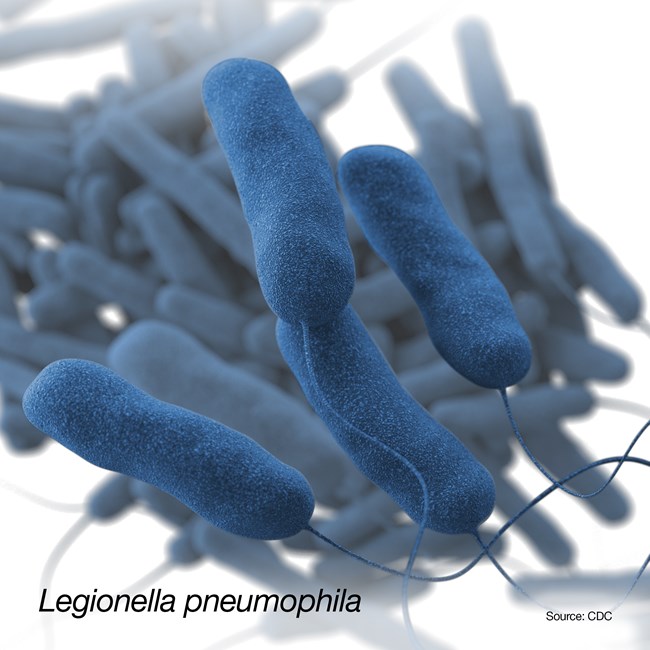Last updated: May 2, 2023
Article
Legionellosis
(This page is part of a series. For information on other illnesses that can affect NPS employees, volunteers, commercial use providers, and visitors, please see the NPS A–Z Health Topics index.)

CDC/ Sarah Bailey Cutchin
Humans: Legionnaires’ disease is a type of pneumonia caused by the Legionella bacterium. Symptoms can include cough, difficulty breathing, fever, muscle aches, and headaches. People can get Legionnaires’ disease when they breathe in small droplets of water in the air that contain the bacteria or, less commonly, when they accidentally aspirate (breathe in) water when drinking. It is almost never spread from person to person. Symptoms usually begin 2–14 days after exposure. People 50 years or older, current or former smokers, people with chronic lung disease, weak immune systems, cancer, or underlying illnesses such as diabetes, kidney failure, or liver failure, are at increased risk of getting sick. Legionnaires’ disease can be treated with antibiotics; however, among those who get sick, the mortality rate can be 10%. There are no vaccines to prevent Legionnaires’ disease. The number of cases reported to the CDC has been rising since 2000, with approximately 10,000 cases reported in 2018.
Animals: Legionnaires’ disease does not usually occur in animals.
Environment: Legionella bacteria are commonly found in the environment. They grow and multiply within amoebae and ciliated protozoa, which can protect them from extreme temperatures and chemicals like chlorine. They grow best within a certain temperature range (77°F-113°F) but can become a health concern when they grow and proliferate in human-made water systems, like showerheads and sink faucets, cooling towers, hot tubs, decorative fountains, hot water tanks and heaters, and large, complex plumbing systems. Air-conditioners do not use water to cool air, so they are not a risk for Legionella growth. There is no known safe level of Legionella in building water systems.
PREVENTION
- Building owners and managers: Consider a Water Management Program to reduce the risk of Legionella growing and spreading. CDC has developed this Water Management Program Toolkit as well as this worksheet to identify buildings at increased risk.
- Building owners and managers: Consult the Legionella Control Toolkit for specific information on preventing the growth of Legionella bacteria in different settings:
- Building owners and managers: Testing may be useful in certain situations, such as within a Water Management Program. If considering testing for Legionella bacteria, we recommend you consult with a Public Health Consultant first.
- If you become ill following a potential exposure, contact your healthcare provider and let them know of your concern. Legionnaire’s disease can be treated with antibiotics.
- Also, please report any confirmed illnesses or clusters of illnesses to the NPs Office of Public Health (publichealthprogram@nps.gov) as directed in the “Disease Reporting” guidance below.

Resources:
- CDC Legionella Page
- Legionellosis: Risk management for building water systems. ANSI/ASHRAE standard 188–2018. Atlanta, GA: ASHRAE; 2018.
- Managing the risk of legionellosis associated with building water systems. ASHRAE Guideline 12-2020. Atlanta, GA: ASHRAE; 2020.
- Cooling Technology Institute. Legionellosis guideline: Best practices for control of Legionella. 2008.
- Cooling Technology Institute, 2020. Guideline (GDL) 159 – Practices to Reduce the Risk of Legionellosis from Evaporative Heat Rejection Equipment Systems. 2020.
- Centers for Disease Control and Prevention. Model aquatic health code.
- Centers for Disease Control and Prevention. Disinfection of hot tubs that Contain Legionella.
- Centers for Disease Control and Prevention. Guidance for Reopening Buildings After Prolonged Shutdown or Reduced Operation.
- NIOSH. Preventing occupational exposure to Legionella -- Preventing Occupational Exposure to Legionella (cdc.gov)
NPS-SPECIFIC PUBLICATIONS
- James AE, Kesteloot K, Paul JT, et al. Potential Association of Legionnaires’ Disease with Hot Spring Water, Hot Springs National Park and Hot Springs, Arkansas, USA, 2018-2019. Emerg Infect Dis. 2022;28(1):44-50. doi:10.3201/eid2801.211090
